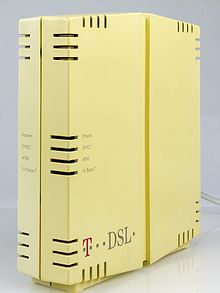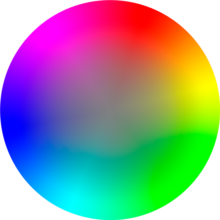Color cast
Under color cast is understood in the color theory , a color nuance , a shift of a color to another color stimulus . The term is defined in DIN 55980.
Color theory
In general, deviations in color tones are described by the color names of the basic colors to which the present color tone tends .
- Blue cast , a color cast into the blue, also referred to as bluish , the color offered is more bluish than desired.
- Green stitch , which is greenish ,
- Red tinge , that is reddish ,
- Yellow tint , that is yellowish .
- A turquoise cast or cyan cast is less common.
The terms Violet random or magenta stitch are not used in practice. Instead, blue-violet color casts are referred to as having a bluish cast, and accordingly the red tones that are tinted with magenta (i.e. ultimately on the blue side of the color wheel) are referred to as blue cast.
The gray cast denotes a lower color saturation with bright colors , with achromatic it is a "darker" white or a "lighter" black. A piece of white fabric, for example, has a gray cast after being washed several times.
Brownish tint is used as a term for muted colors for the warmer color nuance .
As a color tilting color cast is called, differ in which different gray values to different colors with different intensity back.
The definition and use of the term color cast is not uniform. In common parlance, this term is used when describing color nuances in addition to the formation of adjectives for the type of color name. The fresh leaves in May, the may green , is a yellowish green or a yellowish green, it has “a tinge more yellow” than the leaves in summer.
Gilb

A yellow cast in textiles, paper and plastics is also referred to as "yellow". In addition to yellowish substances that already exist in the raw product, products yellow when molecules are broken down and decomposed by aging processes. One-sided yellowing, as occurs on edges or exposed areas, is particularly annoying.
In the past, this yellow tint or brown tinge, i.e. the yellow discolouration, especially of achromatic surfaces, was removed with laundry blue. Degradation products are removed from surfaces by bleach . One way today is preventive additions of optical brighteners or additives that prevent degradation and are used especially for plastics.
Determination of the measure
In principle, the graininess can be determined colorimetrically , but is subject to personal fluctuations in color perception , for example in the case of turquoise (as blue or green). Nevertheless, the recognition of color casts is a basic requirement in dealing with colors and can be trained.
reproduction
In color reproduction , a deviation in the color adjustment from the desired color sample should be avoided. This is attempted by color standards like
- Standard illuminants ,
-
Standard color systems
- CMYK - Euroscale in four-color printing
- Color calibration as with color management in the IT area
- Color profiles for monitors
Color cast in photography
In the case of a photograph , a deviation in the hue of the image from the natural colors is usually undesirable. The most frequent cause of color casts that occur when taking a picture is a color sensitization of the photographic film that does not match the lighting and an incorrect white balance in digital cameras . Another typical cause is film material that is too warm or that has been stored far beyond its use-by date. Added to this are the Schwarzschild and short-term effects with extremely long or short exposure times.
Lighting that is too dark or artificial is a common cause of color cast in a photo. Modern digital cameras have a built-in color correction to avoid a color cast. However, this automatic correction does not always work correctly and does not work with every lighting. The color cast can be corrected or eliminated with the help of digital post-processing.
An incorrectly selected temperature when developing color photos can also change the color tone. However, color casts can also result from incorrect processing, storage and aging of the film material, transport, X-rays or aging of the paper image.
In digital photography , the processes and color spaces used by the camera, the monitor and the imagesetters or printers also have a decisive influence on the correct color reproduction.
Causes of a color cast
Different types of color cast are possible:
- Discoloration in the dark area
- occur especially with paper photos. This is mostly due to the fact that the correct color filter for the type of film was not inserted into the enlarger. Older paper prints may also have faded dyes over time.
- Discoloration in the light area
- are usually justified by the light source: By using a greenish light source such as a fluorescent tube, everything is colored green. This is offset by the use of filter attachments or appropriately sensitized film material. A white balance can be carried out on electronic recording devices.
- Discoloration in the middle brightness range
- These arise, for example, if the gamma value was not taken into account during a subsequent color cast correction using image processing software . In addition, this display error is frequently encountered in printers and even changes from cartridge to cartridge. Incidentally, a slight red cast in the mid-tones can also be desirable in portrait photos, as this makes the person depicted look “fresher”.
Several types of color cast can also occur at the same time: If photos were taken with a daylight film under incandescent lamps , images with a yellow cast in the light areas are to be expected first. Now the machine uses the overall impression of the picture to produce the prints "nonsensically" in order to find the "suitable" filter. This creates an additional blue tint in the dark areas of the image.
A color cast also occurs if the identity color is not represented accurately, but is still acceptable.
Opportunities for correction
A color cast correction with image editing software is possible with relatively little effort . As long as none of the color channels are overdriven, good results are achieved. However, you should try to avoid a color cast when taking the picture so that the negative, file or other original image is produced in the best possible quality.
A color cast correction by optical means is associated with a lot of effort. Low-cost suppliers of paper prints prefer an automatic setting so that the overall impression of the image is neutral gray . The color cast in the light and dark areas is removed by very hard contrasts, but bright colored areas without drawing appear. In such a case, the image information is permanently damaged and can no longer be restored by image processing software. Scanning the negative and doing the arithmetical reversal is better for this.
Intentional color cast
As with toning , color casts can also be used specifically as a stylistic device - as a color filter in front of the lens or (flash) light, through electronic post-processing or deliberate “errors” in normal work steps.
Web links
- Correct the hue and color cast with Gimp
- Light stability and yellowing (explanation of the yellowing of paper on the website of a paper trader)

